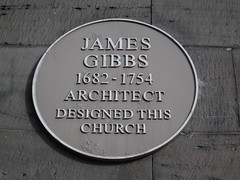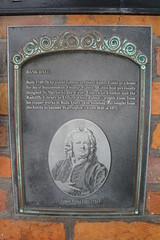James Gibbs
Commemorated on 5 plaques
James Gibbs architect (1682-1754) designed this church
West St Nicholas Church, West Wall, Union Street, Aberdeen, United Kingdom where they designed
Holy Trinity Church Founded by Peter Legh of Lyme Hall in 1709 Holy Trinity was rebuilt in 1760, probably to a design by James Gibbs, the architect of Warrington's Town Hall. The town clock in the tower above has a bell dating from 1647 which once hung in the Court House in the Old Market Place (Golden Square.)
Holy Trinity Church, Market Gate, Sankey Street, Warrington, United Kingdom where they designed
Bank Hall Built 1749-50 by world-famous architect James Gibbs as a home for local businessman Thomas Patten. Gibbs had previously designed St. Martin in the Fields Church in London and the Radcliffe Library in Oxford whilst Patten's wealth came from his copper works at Bank Quay. The building was bought from the family to become Warrington's Town Hall in 1872.
Town Hall, Warrington, United Kingdom where they designed (1749-1750)
Some Notable People Buried Here Edward Forset Lord of the Manor 1630 Sir Edmund Douce Cupbearer to 2 Queens 1644 Dame Francis Howland 1668 Claudius de Crespigny and his wife 1695 Maria de Vierville French refugees 1708 Humphrey Wanley Librarian 1726 James Figg Pugilist 1734 James Gibbs Architect 1754 Edmond Hoyle Writer on games 1769 John Rysbrack Sculptor 1770 John Allen Royal Apothecary 1774 James Ferguson Astronomer 1776 Allan Ramsey Painter 1784 Charles Wesley Divine 1788 Stephen Storace Composer 1796 George Stubbs Painter 1806 3rd Duke of Portland Lord of the Manor 1809 Caroline Watson Engraver 1814
Garden of Rest, Marylebone High Street, London, United Kingdom where they designed
Some Facts of Interest in the History of the Old Church The Church was built to replace the former Church of St John at Tyburn 1400 Francis Bacon was married here 1606 William Hogarth portrayed the interior of the Church 1735 James Gibbs Architect, pupil of Wren was buried here 1754 Richard Brinsley Sheridan married Miss Linley here 1773 Charles Wesley brother of John Wesley was buried here 1788 Lord Byron was baptized here 1788 Lord Nelson worshipped here and Horatia his only child was baptized here 1803
Garden of Rest, Marylebone High Street, London, United Kingdom where they designed






